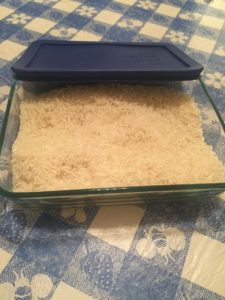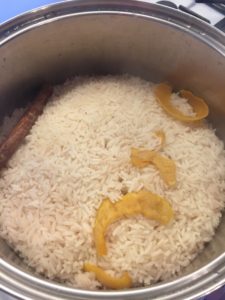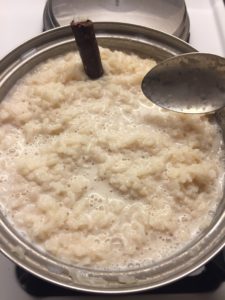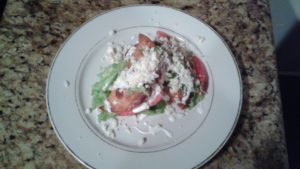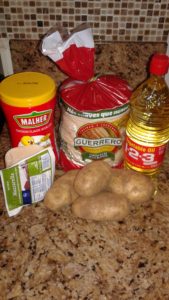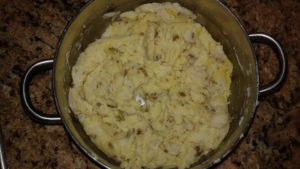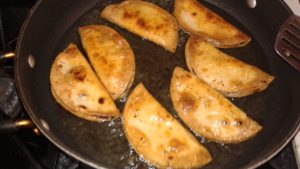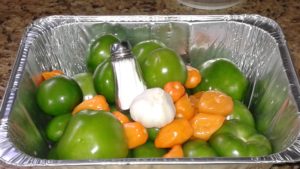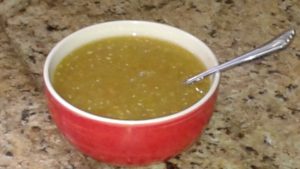Mexican Mole from Scratch
As a child I spent a lot of quality time with my grandmother, in fact she practically raised me. My mother was a single teenage mother who was obligated to spend a lot of her time working, trying to make ends meet. Since I spent most of my time with my lovely grandmother, she was the one who took the responsibility to make sure my needs were being met. In other words, she made sure my belly was always full. My grandmother would always be willing to cook me any meal I craved, she loved to cook for me. Not only because I was her very first grandchild, but because I wasn’t a very good eater when I was growing up. One of favorite dishes I would constantly ask her to make me was her Mexican Chicken Mole (from scratch), a rich savory sauce that has complex layered flavors. Her recipe included:
10-12 Chile Pasilla (stems and seeds removed) 3 Green Tomatoes
8 Chile California (stems and seeds removed) Peanuts (a handful)
4-6 Chile de Arbol ( Spicy) ¼ cup Almonds
1/2 cup Sesame Seeds 2 Garlics
2 tsp Pumpkin Seeds (Peeled) 2 Bay Leaves
1/3 Onion 1 Toasted Bread
Water or Chicken Broth ½ to 1/3 cup Canola Oil
½ Ibarra Chocolate ½ Platano Macho
Salt (to taste)
In brief, I was always amazed at all the ingredients she included in her tasteful Mole sauce; I would’ve never guessed what was in her Mole. Most people I know, typically cook with the Mexican Dona Maria Mole sauce that is pre-made and sold in Mexican grocery stores. I occasionally cook with the pre-made Mexican Dona Maria, but I add other ingredients to make it spicy. However, it is nowhere near as tasteful as my grandmothers Chicken Mole. In fact, it is rare when I come across someone who cooks with precise ingredients, like my Grandmothers homemade Mexican Mole. This particular dish is one of my favorite meals my grandmother cooks because the recipe has been passed on from generation to generation within my family. For that reason, she refused to share her step by step instructions.
As an illustration, an Oaxacan-Style Mole Sauce:
- Manteca(pork lard) or canola oil
- 10-12 chile pasilla, stems and seeds removed
- 8 chile mulato, stems and seeds removed
- 2 teaspoons cumin seeds
- 2 full teaspoon Mexican oregano
- 8-10 cloves garlic, sliced
- 2 cups chicken broth
- 1/4 to 1/3 cup white vinegar
- salt to taste
Instructions:
- Heat 1/3 to 1/2 cup oil to medium heat. After a few minutes, add two of the dried chiles. Cook for just about 20 to 30 seconds per side. They will become brighter in color at first, then start to darken in color. As soon as they become darker, take them out and transfer to a plate. Repeat until all peppers are done. Once peppers are done, break them into smaller pieces(they should be very brittle) and cover them with boiling water. Let them steep.
- In that same pan, add a little more oil and heat to medium/low. Add the cumin seeds, oregano and garlic. Cook stirring often until the spices and garlic become aromatic and slightly toasted. Remove from heat.
- Drain the water from the chiles and transfer them to the blender. Add 2 cups of fresh water or chicken broth and all of the remaining ingredients, including the oil that you cooked the spices in. I prefer not to use the water that the chiles were soaking in. It can be bitter at times. Blend on high until smooth. Taste for salt. Strain sauce through a wire mesh strainer.
1 1/2 teaspoon Mexican oregano 1/4 cup blanched almonds
1 teaspoon cumin seeds 1/4 cup pumpkin seeds
1/2 teaspoon anise 1/2 cup sesame seeds
2 whole cloves 1 large roma tomato
6 to 8 peppercorns 2 to 3 chile serrano
1 inch piece of Mexican cinnamon 6 to 8 cloves garlic
1/2 large white onion 1/3 cup raisins
2 corn tortillas 1 1/2 tbsp. peanuts
1 disc Mexican chocolate 8 to 10 cups chicken broth
Salt and pepper (to taste)
Instructions:
- In one skillet, combine the almonds and pumpkin seeds. Heat to medium and add just a drizzle of oil. When they begin to sizzle, stir as needed and cook just until lightly toasted. Remove from heat and transfer to a small bowl.
- Wipe out that same skillet and add the sesame seeds. Heat to medium and toast until golden in color. Stir as needed. Transfer to a bowl. Wipe out the skillet. Reserve 1/2 of the toasted sesame seeds for garnish on the mole.
- In the skillet, add the spices and heat to medium. When they become aromatic, stir often. Toast for just a few minutes and remove from heat. Wipe out the skillet. Again and finally in this same skillet, add the tomato, onion, serrano and garlic. Drizzle with a little oil and heat to medium. Cook until they begin to char in some spots and cook through. Remove the garlic after 15 minutes. If you feel comfortable toasting several ingredients at once using a few pans, you could do that as well.
- Using a coffee grinder or mini chopper, add the toasted nuts. Grind by pulsing until it resembles a thick paste. Set side. Using a coffee grinder (I use mine strictly for spices) add the toasted spices and seeds. Grind until you have a fine paste/powder. Set aside.
- Once everything is toasted, roasted and charred, add the ground seeds, nuts and spices to the blender. Also add the charred tomato, onion and serrano. Remove skins from garlic and add them, along with the raisins, charred tortillas and peanut butter. Add 2 cups of broth. Blend on high until smooth. For a smoother sauce, strain sauce through wire strainer and set aside.
- In a large oven pot, add 2 tablespoons of pork lard (Manteca) or oil of choice, and heat to medium. After a few minutes when oil is hot, add the strained chile sauce (sauce from dried chiles). Cook for 5 to 7 minutes, stirring as needed. Add the other blended sauce and 6 cups of broth. Bring to a boil, reduce to a simmer and add the Mexican chocolate. Stir as needed to melt chocolate. Cover 3/4 of the way and continue simmering the mole sauce for a good hour or two. The sauce will become darker and thicker as it cooks and reduces. Add extra broth (2 or more cups) depending on how thick you like it. Taste for salt along the way (Pinaenlacocina.com, 2016).
Throughout the years and throughout the nation this Mexican Mole dish has been modified by many and continues to be modified. The sauce is made with numerous ingredients, chili peppers being one of the main ingredients. The original Mole is a dark brown or red sauce that is typically served over meat (preferably chicken). However, Mexican Mole sauces are well-known to come in a variety of flavors and colors. Mole can be anything from soup-like too thick paste like sauce and can be either bright green, brown, red, yellow, or black depending on the region. The different styles of Mole sauce depend on the ingredients you add; the dried chile peppers you decide to use determine the color and taste of the Mole sauce. Also, one can either toast or fry their ingredients which might make a slight different in taste.
Furthermore, Mole is a Mexican sauce that is originated in Mexico, in the states of Oaxaca, Tlaxcala, and Puebla. The dish is recognized as a culinary symbol of Mestizaje (a combination of both Indigenous and European heritage) due to the ingredients the sauce contained. The Mole sauce has a mixture of ingredients that represent either the indigenous or European heritage. This dish was inspired during the Colonial period, a period where people lived in panic because they lived in poverty. Giving them no other option but to gather the little they had and cook it together. For example, day-old bread, nuts, chocolate, spices, and chili peppers were mixed together to create an appetizing sauce to go with a turkey meal. Since the term Mole was an ancient word for mix the Mexican dish was given then name Mole (Mole, Wikipedia, 2016).
One of the main ingredients Chile Pasilla is a dark dried chili pepper that is typically narrow and long. It is recognized for its dark wrinkled skin; it is commonly 6 to 8 inches long and 1.0 to 1.5 inches in diameter. Pasilla is a species that falls under Capsicum annuum, a species native to South America and North America. This chili pepper is sold in the United States, United Kingdom, and Mexico; you can purchase the pepper whole (fresh or dry) or in powdered form. The Pasilla Chile is mild to medium-hot and is normally used to prepare sauces similar to Mexican Mole (Pasilla, Wikipedia, 2016).
Another ingredient that makes a difference in the color of the mole is the Ibarra chocolate. Ibarra is a Mexican chocolate produced by the company Chocolatera de Jalisco of Guadalajara, Jalisco, Mexico. This Mexican chocolate company produces several other chocolate products however, they are known throughout international markets for their famous Ibarra table chocolate. The Ibarra chocolate is about ½ inches thick and 3 ¼ inches in diameter it is shaped in a circle and molded into 8 pieces. This chocolate contains cinnamon flavoring, cocoa liquor (not cocoa butter), vegetable fat, sugar, and soy lecithin. It is typically used to make hot cocoa in a traditional Mexican form (Ibarra, Wikipedia,2016).
In addition, almonds seeds are also included into the Mole sauce to give it a slightly different kick to the favoring of the sauce. Almonds are edible seeds that are widely cultivated from the Almond tree itself. The tree produces a fruit by the name of Majorca which has an outer hull and hard shell with a seed inside (almond seed). These almond seeds can be purchased unshelled or shelled. The blanched almonds have to be treated with hot water to soften the seed coat given one access to the white embryo. In addition, the seed is a very nutritionally dense food; a good source of energy, carbohydrates, fat, protein, vitamins, and minerals. In fact, almonds contain campesterol and stigmasterol, which have been proven to lower cholesterol properties. Lastly, the United States is recognized as the largest almond seed producer. The production is based in California, making almonds the third leading agricultural product in California. In fact, California is known as the dominant supplier of almonds (Almond, Wikipedia, 2016).
To conclude, my grandmother’s Mexican Chicken Mole is a dish that has great significance in my life. It brings nothing but good vibrations and feelings. Every time I eat this particular dish, I recall my childhood. I picture my grandmother in the kitchen, wearing her bright green leafed apron, speaking to me as she takes her sweet time mixing all the ingredients together. By this I mean, the memory of my grandmother making Mole for me is the reason why this dish is so significant to me.
References
“Easy Mole Sauce Recipe -Ixtapa Mexican Restaurant and Cantina, MA.” Ixtapa
Mexican Grill & Cantina. N.p., 2013. Web. 09 Nov. 2016.
Recipe Courtesy of Food Network Kitchen. “Chicken Mole : Food Network Kitchen : Food Network.” Recipe : Food Network Kitchen : Food Network. N.p., n.d. Web. 09 Nov. 2016.
< http://www.foodnetwork.com/recipes/food-network-kitchens/chicken-mole-recipe.html>
Schonwetter, Norma. “Mexican Chicken Mole.” MyRecipes. N.p., 2014. Web. 07 Nov. 2016.
< http://www.myrecipes.com/recipe/mexican-chicken-mole>
Hughes, Chuck. “Estella’s Mole Poblano Chicken : Recipes : Cooking Channel.” Recipes : Cooking Channel. N.p., n.d. Web. 27 Nov. 2016.
< http://www.cookingchanneltv.com/recipes/chuck-hughes/estellas-mole-poblano-chicken.html>
Schnozzles. “Authentic Mole Recipe.” SparkRecipes. N.p., n.d. Web. 27 Nov. 2016.
< https://recipes.sparkpeople.com/recipe-detail.asp?recipe=290049>
“Mole Sauce.” Wikipedia. Wikimedia Foundation, n.d. Web. 26 Nov. 2016.
< https://en.wikipedia.org/wiki/Mole_sauce>
“Pasilla.” Wikipedia. Wikimedia Foundation, n.d. Web. 28 Nov. 2016.
< https://en.wikipedia.org/wiki/Pasilla>
“Almond.” Wikipedia. Wikimedia Foundation, n.d. Web. 12 Nov. 2016.
< https://en.wikipedia.org/wiki/Almond>
@almonds. “History of Almonds.” Almond Board of California. N.p., n.d. Web. 23 Nov. 2016.
< http://www.almonds.com/consumers/about-almonds/history-of-almonds>
Pinaenlacocina.com. N.p., n.d. Web. 27 Nov. 2016.
< http://pinaenlacocina.com/2015/09/22/oaxacan-style-mole-mo-leh-sauce/>

